4. The Julia Language
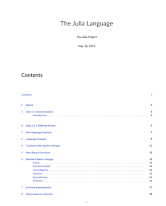 This is the official documentation for Julia. It goes into great depth about the language.
This is the official documentation for Julia. It goes into great depth about the language.
This comprehensive book covers everything from strings, functions, control flow, types, methods, constructors, modules, to multi-dimensional arrays, networking, global variables, environment variables, embedding Julia and so much more.
The Julia language is licensed under the MIT License.
5. Julia by Example by Samuel Colvin
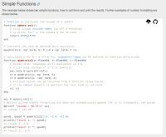
This is a set of articles that offer examples of Julia, the high-level, high-performance dynamic programming language for technical computing.
Covers:
- Hello World.
- Simple Functions.
- Strings Basics.
- String: Converting and formatting.
- String Manipulations.
- Arrays
- Error Handling
- Multidimensional Arrays
- Dictionaries.
- Loops and Map
- Types.
- Input & Output.
- Packages and Including of Files.
- Plotting.
- Winston.
- DataFrames.
This work is published under the MIT License.
6. Learn Julia in Y Minutes by Leah Hanson and many contributors
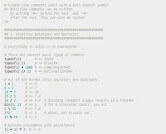 Learn Julia in Y Minutes offers a whirlwind into the Julia programming language.
Learn Julia in Y Minutes offers a whirlwind into the Julia programming language.
The material is community driven.
It’s based on Julia 1.0.0.
This tutorial covers the following topics:
- Primitive Datatypes and Operators.
- Variables and Collections.
- Control Flow.
- Functions.
- Types.
- Multiple-Dispatch.
This work is published under the Creative Commons Attribution-ShareAlike 3.0 Unported (CC BY-SA 3.0) License.
7. Julia: A Fresh Approach to Numerical Computing by Jeff Bezanson, Alan Edelman, Stefan Karpinski, Viral B. Shah
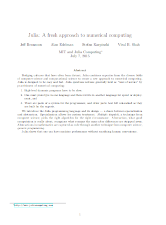 Bridging cultures that have often been distant, Julia combines expertise from the diverse fields of computer science and computational science to create a new approach to numerical computing. Julia is designed to be easy and fast. Julia questions notions generally held as “laws of nature” by practitioners of numerical computing:
Bridging cultures that have often been distant, Julia combines expertise from the diverse fields of computer science and computational science to create a new approach to numerical computing. Julia is designed to be easy and fast. Julia questions notions generally held as “laws of nature” by practitioners of numerical computing:
1. High-level dynamic programs have to be slow.
2. One must prototype in one language and then rewrite in another language for speed or deployment, and
3. There are parts of a system for the programmer, and other parts best left untouched as they are built by the experts.
The authors introduce the Julia programming language and its design — a dance between specialization and abstraction. Specialization allows for custom treatment. Multiple dispatch, a technique from computer science, picks the right algorithm for the right circumstance. Abstraction, what good computation is really about, recognizes what remains the same after differences are stripped away. Abstractions in mathematics are captured as code through another technique from computer science, generic programming.
Julia shows that one can have machine performance without sacrificing human convenience.
8. Algorithms for Decision Making by Mykel J. Kochenderfer, Tim A. Wheeler
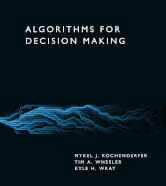 Algorithms for Decision Making is a broad introduction to algorithms for decision making under uncertainty, introducing the underlying mathematical problem formulations and the algorithms for solving them.
Algorithms for Decision Making is a broad introduction to algorithms for decision making under uncertainty, introducing the underlying mathematical problem formulations and the algorithms for solving them.
The book first addresses the problem of reasoning about uncertainty and objectives in simple decisions at a single point in time, and then turns to sequential decision problems in stochastic environments where the outcomes of our actions are uncertain. It goes on to address model uncertainty, when we do not start with a known model and must learn how to act through interaction with the environment; state uncertainty, in which we do not know the current state of the environment due to imperfect perceptual information; and decision contexts involving multiple agents. The book focuses primarily on planning and reinforcement learning, although some of the techniques presented draw on elements of supervised learning and optimization. Algorithms are implemented in the Julia programming language. Figures, examples, and exercises convey the intuition behind the various approaches presented.
Pages in this article:
Page 1 – Think Julia: How to Think Like a Computer Scientist and more books
Page 2 – The Julia Language and more books
All books in this series:
| Free Programming Books | |
|---|---|
| Ada | ALGOL-like programming language, extended from Pascal and other languages |
| Agda | Dependently typed functional language based on intuitionistic Type Theory |
| Arduino | Inexpensive, flexible, open source microcontroller platform |
| Assembly | As close to writing machine code without writing in pure hexadecimal |
| Awk | Versatile language designed for pattern scanning and processing language |
| Bash | Shell and command language; popular both as a shell and a scripting language |
| BASIC | Beginner’s All-purpose Symbolic Instruction Code |
| C | General-purpose, procedural, portable, high-level language |
| C++ | General-purpose, portable, free-form, multi-paradigm language |
| C# | Combines the power and flexibility of C++ with the simplicity of Visual Basic |
| Clojure | Dialect of the Lisp programming language |
| ClojureScript | Compiler for Clojure that targets JavaScript |
| COBOL | Common Business-Oriented Language |
| CoffeeScript | Transcompiles into JavaScript inspired by Ruby, Python and Haskell |
| Coq | Dependently typed language similar to Agda, Idris, F* and others |
| Crystal | General-purpose, concurrent, multi-paradigm, object-oriented language |
| CSS | CSS (Cascading Style Sheets) specifies a web page’s appearance |
| D | General-purpose systems programming language with a C-like syntax |
| Dart | Client-optimized language for fast apps on multiple platforms |
| Dylan | Multi-paradigm language supporting functional and object-oriented coding |
| ECMAScript | Best known as the language embedded in web browsers |
| Eiffel | Object-oriented language designed by Bertrand Meyer |
| Elixir | Relatively new functional language running on the Erlang virtual machine |
| Erlang | General-purpose, concurrent, declarative, functional language |
| F# | Uses functional, imperative, and object-oriented programming methods |
| Factor | Dynamic stack-based programming language |
| Forth | Imperative stack-based programming language |
| Fortran | The first high-level language, using the first compiler |
| Go | Compiled, statically typed programming language |
| Groovy | Powerful, optionally typed and dynamic language |
| Haskell | Standardized, general-purpose, polymorphically, statically typed language |
| HTML | HyperText Markup Language |
| Icon | Wide variety of features for processing and presenting symbolic data |
| J | Array programming language based primarily on APL |
| Java | General-purpose, concurrent, class-based, object-oriented, high-level language |
| JavaScript | Interpreted, prototype-based, scripting language |
| Julia | High-level, high-performance language for technical computing |
| Kotlin | More modern version of Java |
| LabVIEW | Designed to enable domain experts to build power systems quickly |
| LaTeX | Professional document preparation system and document markup language |
| Lisp | Unique features - excellent to study programming constructs |
| Logo | Dialect of Lisp that features interactivity, modularity, extensibility |
| Lua | Designed as an embeddable scripting language |
| Markdown | Plain text formatting syntax designed to be easy-to-read and easy-to-write |
| Objective-C | Object-oriented language that adds Smalltalk-style messaging to C |
| OCaml | The main implementation of the Caml language |
| Pascal | Imperative and procedural language designed in the late 1960s |
| Perl | High-level, general-purpose, interpreted, scripting, dynamic language |
| PHP | PHP has been at the helm of the web for many years |
| PostScript | Interpreted, stack-based and Turing complete language |
| Prolog | A general purpose, declarative, logic programming language |
| PureScript | Small strongly, statically typed language compiling to JavaScript |
| Python | General-purpose, structured, powerful language |
| QML | Hierarchical declarative language for user interface layout - JSON-like syntax |
| R | De facto standard among statisticians and data analysts |
| Racket | General-purpose, object-oriented, multi-paradigm, functional language |
| Raku | Member of the Perl family of programming languages |
| Ruby | General purpose, scripting, structured, flexible, fully object-oriented language |
| Rust | Ideal for systems, embedded, and other performance critical code |
| Scala | Modern, object-functional, multi-paradigm, Java-based language |
| Scheme | A general-purpose, functional language descended from Lisp and Algol |
| Scratch | Visual programming language designed for 8-16 year-old children |
| SQL | Access and manipulate data held in a relational database management system |
| Standard ML | General-purpose functional language characterized as "Lisp with types" |
| Swift | Powerful and intuitive general-purpose programming language |
| Tcl | Dynamic language based on concepts of Lisp, C, and Unix shells |
| TeX | Markup and programming language - create professional quality typeset text |
| TypeScript | Strict syntactical superset of JavaScript adding optional static typing |
| Vala | Object-oriented language, syntactically similar to C# |
| VHDL | Hardware description language used in electronic design automation |
| VimL | Powerful scripting language of the Vim editor |
| XML | Rules for defining semantic tags describing structure ad meaning |
